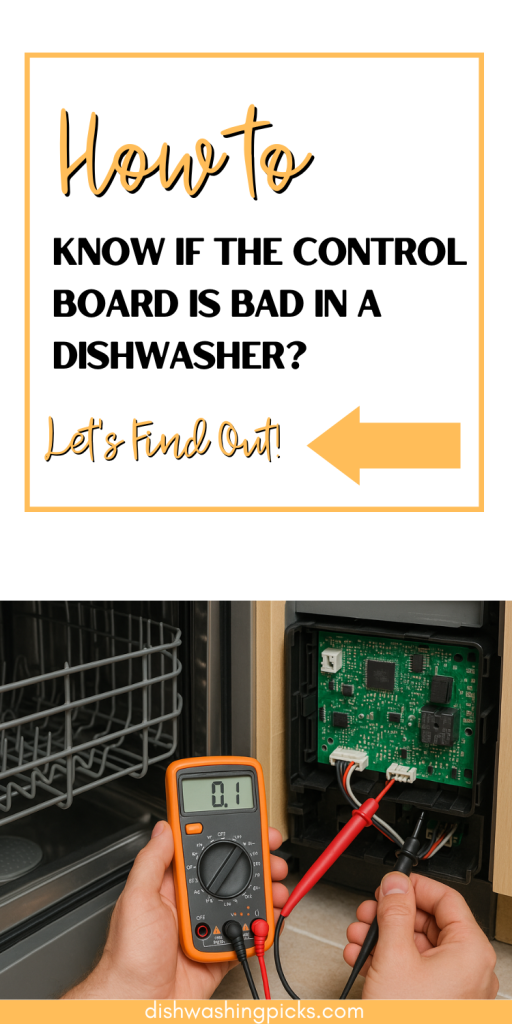
Let’s Start Here…
So, you hit the start button on your dishwasher, expecting it to whir to life like usual. But instead? Crickets. Or maybe the lights flicker weirdly. Or it does start, but then it just… gives up halfway and blinks at you like it’s confused.
Now you’re standing there thinking, “Is it me? Did I do something? Is this dishwasher gaslighting me?”
Chances are, it’s not personal. It might just be the control board—the little brain inside your dishwasher that tells everything else what to do. And when it starts acting up? Well, the rest of the dishwasher follows suit.
But how do you know if that’s the issue and not, say, a door latch or a loose wire? Great question. Let’s walk through the signs together, figure out what’s going on, and get you back to clean-dish bliss.
First Off—What Even Is the Control Board?
Okay, real quick: the control board (sometimes called the main control board or electronic control board) is basically the boss.
It tells the dishwasher:
- when to fill with water
- when to spray
- when to drain
- how long to wash
- when to dry
It’s the coordinator of all the behind-the-scenes action. Without it, the dishwasher is just a box with racks and buttons that don’t actually do anything.
So yeah… kinda important.
Sign #1: Buttons or Display Are Acting Weird
If the display is flickering, random buttons aren’t responding, or the panel lights are lighting up like it’s New Year’s Eve—even though you didn’t press anything—something’s off.
Now, before you jump to conclusions:
Try a quick hard reset.
Unplug the dishwasher (or flip the breaker) for about 5 minutes. Then power it back up and see what happens.
🎯 If it starts working again, congrats! You just fixed it with the ol’ “turn it off and on again” trick. If not… keep reading.
Sign #2: It Starts… Then Suddenly Stops
This one’s super frustrating. Your dishwasher powers up, hums to life, maybe even fills with water—and then… it just stops. No draining. No spraying. No finish.
If your power supply is fine, the door is latched, and you haven’t tripped a fuse, that points to a glitchy control board that just can’t follow through with the rest of the cycle.
Imagine trying to cook dinner and halfway through the recipe, your brain just forgets what step comes next. That’s your dishwasher on a bad control board.
Sign #3: It Won’t Start at All (Even With Power)
Alright, this one’s the big red flag.
If you’ve confirmed that the dishwasher is getting power (lights on, outlet working, no tripped breaker), but the control panel is totally unresponsive—like no beeps, no lights, no signs of life—yeah, your control board may be toast.
But just to be sure…
Check the door latch first.
Dishwashers won’t start unless the door thinks it’s securely closed. If the latch sensor is broken, the control board won’t even try to start a cycle. It’s a safety thing.
Still no dice? Then it’s likely the board.
Sign #4: The Dishwasher Is Running Totally Out of Whack
Some dishwashers will start with a faulty control board… they just won’t do anything correctly.
We’re talking:
- super short cycles that barely clean
- skipping steps (like, hello? why are my dishes still dripping wet?)
- draining in the middle of a wash
- lights blinking out of sequence
- soap dispenser popping open at the wrong time
If your dishwasher’s acting like it’s lost its mind but the parts themselves seem fine, the control board might be glitching out and sending mixed signals.
Sign #5: Diagnostic Mode Says So (If You Want to Get Fancy)
Most newer dishwashers have a diagnostic mode—a kind of “secret menu” for technicians (and curious DIYers) to check for error codes.
You’ll need to Google the steps for your specific brand/model (they’re all slightly different), but it usually involves pressing a certain button combo in a specific pattern—kind of like unlocking a cheat code in a video game.
If you can get into that mode and the board throws out an error code that matches a “control board failure,” well… that’s your answer right there.
⚠️ Just don’t get too caught up in codes if you’re not used to them—they’re handy, but they can also point to multiple issues. Use it as one clue, not gospel.
So… Can You Replace a Control Board Yourself?
Short answer: yes, if you’re a little handy and not scared to use a screwdriver.
Most control boards are located behind the control panel at the top of the door. You’ll usually need to:
- unscrew the inside door panel
- carefully unplug the old board (lots of little connectors—take a pic first!)
- plug in the new one the same way
- reassemble everything
Takes about 30–45 minutes if you’re confident and careful. The part usually costs between $75–$200 depending on the brand.
If that sounds overwhelming? Totally fine to call in a pro. But at least now you’ll know what you’re dealing with—so you’re not going in blind or paying for “mystery repairs.”
Final Thoughts: Trust the Signs
Control boards don’t fail that often, but when they do, they leave a trail of clues. So if your dishwasher is:
- unresponsive,
- acting wild,
- randomly quitting,
- or just not doing its job right…
…and you’ve already ruled out the basics (power, door latch, clogged filters), then yeah—it might be time to look at the control board.
But here’s the good news:
Knowing what the signs mean gives you a head start. Whether you DIY the fix or call in help, you’re not guessing—you’re diagnosing.
And honestly? That’s half the battle right there.
